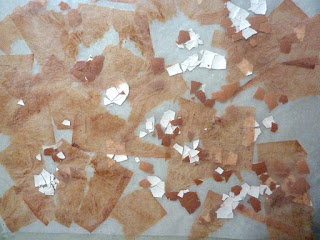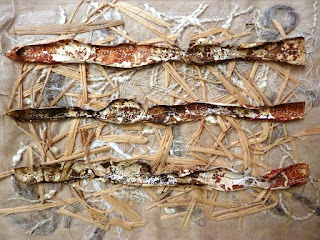I liked the design of my totem silhouette piece in
10.4 but wanted the colours to be more akin to the Aboriginal research of my module so I used a cream woven linen as the background and bonded cut chiffons and organzas on to that. It measured 20cm by 45cm and was backed by bonding to a stiff batting 2mm thick to support its own weight.
 |
| 10.8: Totem background of linen weave with bonded sheer fabric shapes |
I then free machined seed stitching in white to emphasise the edges
 |
| 10.9: Totem background of linen weave with bonded sheer fabric shapes and free machining |
I wanted to add dimensional shapes to the background similarly to those in
10.7 where thick batting was sandwiched between fabric on either side by bonding. The fabric here was recycled teabags and yarn covered by sheer organzas - white on one side and back on the other. I wanted the shapes to be reversible.
I simplified the motif slightly, edged them with machine stitching and wrapped each with linen twine to recreate Aboriginal stripe markings. Each shape is approx 8cm by 6cm.
As this was my last practical piece for the diploma (sob!) I felt this totem should be a retrospective of my work in the 6 modules so each shape has hanging detail representative of a particular module:
 |
10.10a: totem motifs (l to r) gumnut and bark - Vegetation theme research in Module 1,
coiled metal wire bead - Metal in Module 2,
folded braiding - Strapwork in Module 3 |
 |
10.10b: totem motifs (l to r) cardboard motif - Slipwork in Module 4,
laminated lace - Transparentcy and lace in Module 5,
shrunck plastic gumnut - recycled materials in Module 6 |
Each shape had a 'hook' in the outline to enable it to remain attached to the background when inserted through a cut slit (like a self supported hanging shelf).
The background was formed into a tube and the whole totem can be seen in 10.11 with the shapes attached.
 |
| 10.12 Totem resolved |
Some other shots of the tubular totem -
 |
| 10.13 |
 |
| 10.14 |
 |
| 10.15 Back of the totem showing reverse of the shapes |
I also rather liked the totem flattened out as a wall piece (10.16), since the motifs still protrude slightly into the room at an angle and the background pattern is more apparent.
 |
| 10.16 |
 |
| 10.17 |
 |
| 10.18 |
 |
| 10.19 |











































